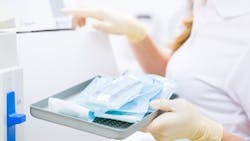Optimize sterilization: How dental assistants can save the practice time and money
There is an adage that says, “Fast, good, or cheap? Pick two.” While this is the case for many things, it isn’t necessarily true about operations in the sterilization area. The most important consideration in this area is to make sure everything is safely reprocessed. With new technology and smart workflows, you can optimize efforts to ensure that the practice runs smoothly, safely, and economically.
Optimize workflow
It all starts with dirty instruments in the sterilization area. The design of this area in your practice is a big factor in overall efficiency. Having enough space to work is critical. You also need a large enough sink so there are no accidental sharps injuries. According to the Occupational Safety and Health Administration (OSHA), “Employers also must ensure that reusable sharps that are contaminated are not stored or processed in a manner that requires workers to reach by hand into the containers where these sharps have been placed.”1
Designing a large sterilization area is great, but not every practice has the luxury or means to invest into designing their dream sterilization center. Before instruments even make it to sterilization, cassettes can be used chairside, which optimizes workflow. Using a cassette can save several minutes per instrument set. That may not seem like much time, but over the course of the day those minutes add up. Using cassettes allows the instruments to be neatly and safely contained. Cassettes also help keep track of instruments, reduce accidental damage to the instruments, and reduce team member injury during handling.
Steps for cleaning
The next step in the workflow is instrument cleaning. You might believe this is an easy step to skip in the interest of speed and efficiency, however, it absolutely must be done. Instruments cannot be sterilized unless they are clean. This can be done by hand. In fact, there was a time when the only option for instrument cleaning was hand-scrubbing.
Thankfully, ultrasonic cleaners and instrument washers are now available and, ideally, should be an every stericenter. This is because a cassette can simply be loaded into the washer, eliminating the need to presoak and wash by hand. The beauty of the system is that it eliminates the need to handle instruments, thus maximizing efficiency and removing elements that could lead to injury.
It gets better: much modern cleaning equipment is computer-enabled. The operator can receive notifications when the cleaning process is done or if there is a problem. For instance, if bioburden remains and was baked onto instruments during sterilization, that material would not make it to the chairside, and a team member would not need to stop what they’re doing to get another packet of instruments.
Also by Karen Daw
To the rockin' dental assistants in charge of OSHA and infection control
Top 5 reasons your office should consider instrument cassettes
Hand hygiene: Are dental professionals doing it right?
The sterilization process
The engine room, if you will, of the stericenter is the sterilizer. This is where those washed instruments—that appear clean and safe to the naked eye—get that final touch to become safe. Any remaining microorganisms are blasted away by steam heat. For the sake of speed and efficiency, look for a sterilizer with sterilization and dry times that are as low as possible. For instance, several sterilizers take more than an hour to complete a sterilize and dry cycle. However, other models can do it in less than 40 minutes. An extra 20 minutes per load really adds up and is a huge reduction in stericenter bottlenecks.
Another technology to look for is closed-door drying and vacuum technology, which results in perfectly dried instruments every time. The units that do not employ this technology pose a risk to staff being burned by hot steam escaping the unit when the door opens. Not only are staff at risk, but the hot steam has the potential to damage the stericenter’s cabinetry. Further, team members might be tempted to pull out wet packs to use. These must thoroughly dry because wet packs are not considered sterile since they can wick in contaminants.
Chamber size is another thing to consider. Look for a sterilizer that strikes a balance between chamber size and maximizing counter space. You don’t want something that takes up too much counter real estate, but you do want something with the largest chamber size possible. A large chamber and fast cycle allow your office to process two loads in the same time it takes a smaller, slower unit. Further, find a sterilizer that comes standard with pouch racks. This feature enhances efficiency, but since it’s an add-on, it will cost some extra money.
I talked earlier about ultrasonic cleaners and instrument washers that can connect to smart devices, providing progress updates. That same technology exists for sterilizers, and it would be wise for you to check it out. A sterilizer that sends information about cycle data, instructions, and maintenance notifications provides yet another layer of efficiency. Models with this technology can also be remotely supported by the manufacturer’s technicians, saving even more time.
Finally, look for a sterilizer that uses fresh water in every cycle. This reduces the buildup of oils and debris. Sterilizers that reuse water get dirtier over time. The advantages of using clean water every time should seem obvious: first, contaminants don’t build up within the machine and increase the potential for mechanical damage. The more immediate concern, however, is that dirty water takes longer to clean while clean water can get the job done in 10 minutes.
Storage can help streamline
“Storage” seems straightforward, but this is another area for optimization. Designating specific areas, such as certain cabinets or drawers, for sterile items ensures that instruments won’t get lost. For instance, think about where you keep your car keys. If you keep them right next to the door, you know where they are when it’s time to leave.
According to the Centers for Disease Control and Prevention (CDC), “Sterile instruments and supplies should be stored in covered or closed cabinets. Dental instruments and supplies should not be stored under sinks or in other places where they might become wet. Wrapped packages of sterilized instruments should be inspected before opening and use to ensure that the packaging has not been compromised (i.e., wet, torn, or punctured) during storage.”2
Perform an evaluation
Finally, make the effort to periodically evaluate the overall process. Talking with team members or bringing in an outside consultant can be very effective in ferreting out process inefficiencies. In fact, an outside consultant can look at your whole workflow with fresh eyes and point out inefficiencies that perhaps you’ve gotten used to.
OSHA advises monitoring “lagging and leading indicators” to help evaluate and optimize your efforts. It says, “Lagging indicators generally track worker exposures and injuries that have already occurred. Leading indicators track how well various aspects of the program have been implemented and reflect steps taken to prevent injuries or illnesses before they occur.”3 Determining what works and what doesn’t will help fine-tune your efforts and lead to a practice that is speedy, economical, and safe.
References
1. Protecting yourself when handling contaminated sharps. OSHA Fact Sheet. https://www.osha.gov/sites/default/files/publications/bbfact02.pdf
2. Sterilization: Packaging and storage. CDC. Reviewed February 26, 2016. https://www.cdc.gov/oralhealth/infectioncontrol/faqs/packaging-storing.html
3. Recommended practices for safety and health programs. US Department of Labor. https://www.osha.gov/safety-management/program-evaluation#ai1
About the Author

Karen Daw, MBA, CECM
Karen Daw, MBA, CECM, is an award-winning national speaker, author of numerous articles and CE courses on safety in dentistry, and a trainer for practices and health-care systems across the country. She earned her BA from Ohio State University and her MBA with concentrations in healthcare administration and business management. After graduating, Daw was recruited from the emergency department to become assistant director of sterilization monitoring and health and safety director for the OSU College of Dentistry. She is a proud member of the Organization for Safety Asepsis and Prevention, where she served as cochair for their annual conference and infection control boot camp.
Updated December 14, 2021
